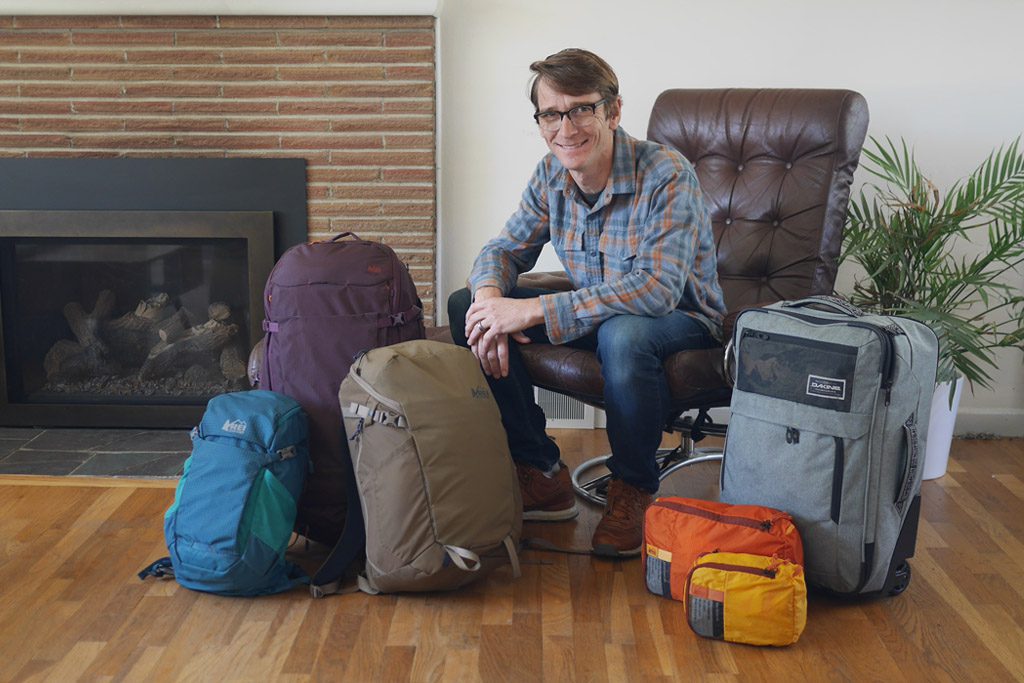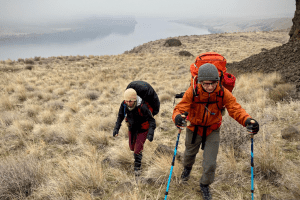Skift Take
Good travel gear that does what you want without fuss can make a good trip even better. But a lot goes into designing those goods, something industrial designer Graeme Wagoner, who has worked on some of the best bags of the year, knows well.
 Every month Skift will profile someone working in the quirkiest, most incredible and surprising jobs in global travel. Skift's relentless curiosity about our industries extends to every corner of the labor market. Who knew jobs like this even existed?
Every month Skift will profile someone working in the quirkiest, most incredible and surprising jobs in global travel. Skift's relentless curiosity about our industries extends to every corner of the labor market. Who knew jobs like this even existed?
We’ve all been there: you’re hiking an alpine trail and stop to take in the view on a promontory. You lean over to tie your shoe and, before you know it, your water bottle comes flying out of a pocket in your pack never to be seen again. You might call it bad luck but Graeme Wagoner would call it bad design.
“We always talked about the people who hit their own dogs with their water bottle when they’re hiking,” said Wagoner. An industrial designer, he believes strongly that a pack needs to work as expected — including not allowing water bottles to fall out of pockets.
Travel gear has become a huge and growing business in recent years, and companies are constantly scouring talent for the next big thing in design and functionality, especially now that the pandemic has created legions of travelers looking to be outdoors.

Graeme Wagoner is an industrial designer who worked on some of REI’s top packs. These are some of his working drawings. Source: Graeme Wagoner.
Wagoner, 41, has designed some of the top packs in America in recent years. During nearly five years at outdoor retail giant REI, where he worked on the Ruckpack collection — the Ruckpack 60+ called the “best travel backpack” of 2021 by the Wirecutter — and the Traverse collection. Prior to that, he was on the design team at bag-maker Dakine.
But designing the “best” pack is not a simple task. It’s a lengthy and intensive process involves everything from collecting reams of user feedback to sketching ideas, building and testing prototypes, before it all comes down to what is ultimately an affordable — and buildable pack — for the public. This is a process that every hiker and traveler can appreciate; no one wants their water bottle to fall out and or our passport difficult to grab as we return to international travel.
Wagoner and his compatriots specialize in making well-designed and functional bags a reality. It’s a lesser appreciated but integral part to everyone’s travel experience. A good bag will always be there but also a forgettable part of a trip, while a bad bag will be memorable in all the wrong ways — making a trip more frustrating and likely less enjoyable.
“A really fancy backpack [that’s] difficult to adjust, often ends up on the wall,” said Wagoner.
The Traverse
“It’s a sobering moment when you are the designer of a pack that are out on 10 people’s backs, and they’re very frank about what they like, and don’t like,” said Wagoner on testing the updates he and his colleagues made to the Traverse collection. The designers took groups on four testing trips in the Pacific Northwest and Southwest — literally into the outdoors — where users were, as he put it, very frank about what they thought of the bag.
REI first released its Traverse line of packs in 2018. The aim was to create a more environmentally sustainable and affordable line of gear by using 100 percent recycled fabric. The number after Traverse — 32, 60, etc — refers to the capacity of the bag. For example, the Traverse 60 can hold up to 60 liters of stuff.
Wagoner worked on the update to the Traverse 60, a process that occurs roughly every three years. The updates are often prompted by negative user feedback, new products from the competition or both. He began the process by gathering feedback — or “insights” as he put it — from a myriad of sources, including users, REI store staff, online reviews and even threads on Reddit.
“I’m very interested in hacks and DIY [do it yourself] solutions to problems that people are finding that they just can’t buy a solution for,” said Wagoner. “I think the internet is a fountain of information from people who want to share things that they’ve discovered.”
He is also very observant. Traveling prior to the Covid-19 pandemic, Wagoner described watching how people load and unload stuff from their packs; how they place them in the overhead bin; and other ways they use and interact with their gear. All these observations factor into his designs for bags like the Traverse.
While the process was similar to that with other packs, Wagoner said the Traverse 60 update involved “a lot of complex issues coming together.” Those included designing a pack that easily held 35 pounds of stuff without adding too much bulk of its own, ensuring it was durable enough to last a decade, and making it easily adjustable with fits for a broad variety of torsos.
The process came together with Outside calling the updated pack the best for backpacking on a budget in its 2021 recommendations. “The Traverse proves that fancy technology is never a substitute for smart design,” the magazine said of the pack in a nod towards Wagoner’s work.
Industrial to Gear Design
Wagoner grew up in New England and studied industrial design at Syracuse University. Always interested in the outdoors, he said he did not become what he considers and outdoors person until he moved west after college to Portland, Ore. There he was taken by the “massive trees and the snow-capped peaks in the middle of summer and all of that.”
In Oregon, he got into cycling, hiking and snowboarding, to name a few activities. Asked how his active lifestyle factors into his work, Wagoner said it is “really helpful” when it comes to excelling at designing outdoors gear. “It also makes it more fun,” he added.
Today, Wagoner lives in the Seattle area and is a frequent cyclist. Asked whether he uses any of the gear he has designed, and he said yes, often prototypes that are one step before the production line.
“It’s always sobering to be far away from home and working with something that you built, making sure it actually works or finding out that it doesn’t,” he said.
But Wagoner emphasized that focusing just on one’s interests is not what makes a good designer. Designing good — or “best” as Outside and the Wirecutter put it — involves looking beyond what you want in or think is best for a pack, and taking a collectivist approach gathering insights, as he put it, from others.
Asked how one gets into gear design, Wagoner recommends an industrial design degree. Another option is a degree in soft goods design with some schools even offering programs specializing in outdoors products, he added. Utah State, for example, offers one such program in outdoor product design and development.
Sustainable Future
With packs seemingly outfitted with every pocket or pouch for all the gadgets and water bottles we can bring with us, one has to stop and wonder where they go next. New materials can make them lighter — just think of the canvas Jansport backpacks of 20 years ago (not a bottle pocket in sight!) compared to the lightweight back-to-school gear of today. But the focus for designers is not so much on new materials, or even new pockets for the next “it” device, but on sustainability.
“Environmental responsibility is a much bigger conversation point than it used to be. It used to be a nice to have … but now it’s becoming more and more commonplace,” said Wagoner. One way he and his colleagues seek to demonstrate a pack’s environmental bonafides is by achieving Bluesign certification.
Bluesign is, for all intents and purposes, the Energy Star equivalent of outdoors goods. Awarded by Switzerland-based Bluesign Technologies, the evaluation takes into account the entire ecosystem behind a specific product — from textiles to dyes, transport and worker conditions — to measure their sustainability and whether or not to certify them with a Bluesign tag. Brands that partner with Bluesign include Eddie Bauer, The North Face, Patagonia and REI.
But using materials that meet sustainability metrics is only one aspect of making more environmentally-friendly gear. For example, Wagoner said designers are often tasked with reviewing fabric patterns for gear to find tweaks that will reduce the amount of material wasted during the cutting process.
Another thing designers look at is durability. It’s well known that keeping and reusing gear and garments — as opposed to fast fashion’s use it and toss it mentality — is one of the easiest ways to reduce waste and be more sustainable. At REI, Wagoner worked on creating a standard set of buckles and straps for the retailers gear. The more standardized these elements of a pack are, the easier they are to replace and extend the life of.
For all his work behind the scenes designing gear used by people all over the world, Wagoner still appreciates seeing packs he designed in the wild.
“When you see someone who’s on the other side of the world from where they live and they’re using something that you made, that’s always a great feeling,” he said. Maybe he’ll spot a Ruckpack or Traverse on an Alpine trail sometime soon.
The Daily Newsletter
Our daily coverage of the global travel industry. Written by editors and analysts from across Skift’s brands.
Have a confidential tip for Skift? Get in touch
Tags: at your service
Photo credit: Graeme Wagoner among his packs and luggage that he has designed. Graeme Wagoner


